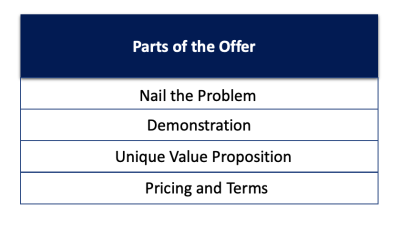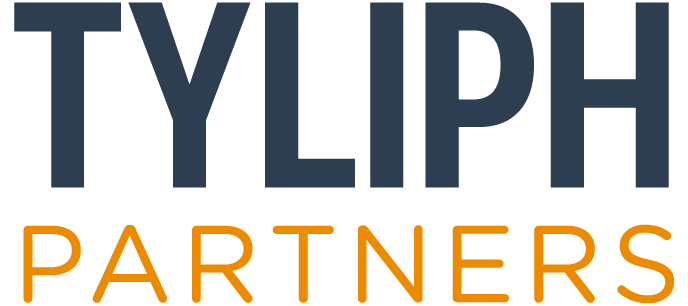
4: An Offer They Can’t Refuse
They say that if it sounds too good to be true, it probably is. The key is crafting a credible offer you can deliver that your customer finds irresistible.
In The Godfather mafia boss Don Vito Corleone says, “I’m gonna make him an offer he can’t refuse.” Of course, it is intended as a threat. Running a business, it’s your job as a company founder to craft an offer so compelling that your customers want to sign up for it.
This is not just an offer in the sense of a legal contract (with its constituent parts of the offer, acceptance, consideration, and capability). This is the larger bundle of values that will convince the customer to buy your package. There are four parts to an offer:

First of all, you have to be able to show that your product fixes the problem the customer is willing to pay for. As I explained in the last two chapters, a product is the sum of its parts – and there are many parts. Indeed, tech startups tend to underestimate how many parts go into making a product. Nailing the problem means going well beyond the core. You have to be able to explain the problem better than the customer can to show that you totally understand it. It’s an unspoken request. In Never Split the Difference, Chris Voss and Tal Raz suggest you that have to employ the strategies and techniques of the negotiator. In showing that your product or service nails their problem, you have to display empathy towards your customer by understanding their emotions, learning to see the problem from their viewpoint — to the extent that they to feel comfortable enough with you to let their emotional guard down. A customer is much more likely to buy from a vendor who ‘gets it’ than from one who doesn’t.
Next, comes a demonstration. According to the dictionary definition, a demo is,
“an act of showing that something exists or is true by giving proof or evidence.”
In a demo you show the customer how the product or service works to fix their real-world problem. Seeing how it works with their own eyes enables the customer to imagine how it would apply in their own circumstances. Words and pictures come alive in the customer’s head, turning into excitement. That’s precisely the emotional state you need for the customer to buy what you are offering. In crafting your offer, you should decide how you will create a compelling demo to create that excitement.
The Unique Value Proposition (UVP), AKA Unique Selling Proposition (USP), is the articulation of the array of elements that differentiates your company’s products or services. The concept was first expounded by E. Jerome McCarthy in his book Basic Marketing: A Managerial Approach. It’s a brief statement which informs customers about why they should choose your offering and not the competition’s. In effect, a UVP is the elevator pitch for the product. An UVP comprises five elements:
- Benefits;
- Emotive;
- Key selling points;
- Key difference;
- Competitive advantage.
Just as film makers have loglines to distill the important elements of their screenplay to audiences, product and service companies communicate their UVPs to customers in taglines. By way of examples:
Allstate: “You’re in Good Hands.”
Amazon: “Work Hard, Have Fun, Make history.”
Apple: “Think Different.”
Bayer: “Science for Better.”
Burger King: “You Rule.”
FedEx: “Where Now Meets Next.”
Nike: “Until We All Win.”
PBS: “Viewers Like You.”
3M: “Science. Applied to Life.”
As a planning exercise you should assemble your team and workshop a memorable and meaningful tagline that articulates your UVP. I have personally led these sessions. They reveal what your team members believe what your company and its products stand for; prepare yourself to be surprised that team members often perceive different things about them, especially those in a product development compared to a customer-facing sales function. Achieving alignment on this point between between functions is vital. Things to consider when coining your tagline:
- Memorability;
- Simplicity;
- Emotion; and
- Differentiation.
Lastly there are the pricing and terms. Pricing is such a big subject we’ll return to it in another chapter. Here, in the context of crafting the offer, it is important to note that pricing and the terms and conditions have to fit with your customer’s expectations. These elements have to be related to what the customer already knows, both so that they can understand them, but also so they are not disappointed or frustrated. Knowing the competitive landscape is crucial so that you understand the cost of alternatives available to customers. It helps that you position your product or service as ‘as good as’, or ‘better than’, or ‘the best’ in your market space.
Crucial to a successful product launch is to have the optimum offer. Testing different combinations of elements with Early Adopters will save much heartache later. When you have validated your product offer, you’ll be in the enviable position of being able “to make him an offer he can’t refuse” – in the nicest possible way.
Lindsay Powell is a Partner and Co-founder of TYLIPH Partners, which offers its clients access to people with actionable insights to position new tech companies for long-term success.
© Tyliph Partners |
